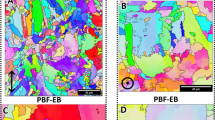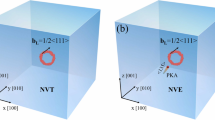Abstract
Boron (\(\mathrm{B}^{10}\))-based materials such as boron carbide (\(\mathrm{B}_4\mathrm{C}\)) are used in control rods of the nuclear reactors because of their high neutron capture cross section and resistance to thermal and chemical degradation. There is an interest to consider other materials that may serve this purpose. In particular, boron-doped diamonds are prospective candidates as they are known to have excellent mechanical strength. In this work, molecular dynamics (MD) simulations are used to characterize and compare the basic radiation damage properties of boron-doped diamond with the stoichiometric formula \(\mathrm{BC}_3\). Only cubic structures of \(\mathrm{BC}_3\) were considered since the experimentally synthesized structure (as per existing literature) was cubic. The basic radiation damage properties compared include threshold displacement energy, primary damage and defect cluster analysis. In addition, the propensity of the material to amorphize under radiation (RIA – radiation-induced amorphization) was also analysed. It was found that the three materials had very similar threshold displacement energies and hence responded to radiation damage in an identical manner. Furthermore, it was seen that none of them were as favourable as the commonly used \(\mathrm{B}_4\mathrm{C}\), as all of them amorphized at lower doses. Consequently, it is concluded that \(\mathrm{BC}_3\), while having excellent mechanical properties, may not have good radiation resistance.



















Similar content being viewed by others
Abbreviations
- RIA:
-
Radiation-induced amorphization
- MD:
-
Molecular dynamics
- PKA:
-
Primary Knock on Atom
- B:
-
Boron
- C:
-
Carbon
- \(\mathrm{BC}_3\) :
-
A type of boron-doped diamond
- c-\(\mathrm{BC}_3\) :
-
Cubic polytype of \(\mathrm{BC}_3\)
- \(\mathrm{B}_4\mathrm{C}\) :
-
Boron carbide
- SiC:
-
Silicon carbide
- \(E_d\) :
-
Threshold displacement energy
- \(\alpha \) :
-
Linear coefficient of thermal expansion
- DTA:
-
Dose to amorphization
- \(V_B\) :
-
Boron vacancy
- \(V_C\) :
-
Carbon vacancy
- \(B_i\) :
-
Boron interstitial
- \(\mathrm{C}_i\) :
-
Carbon interstitial
- \(B_C\) :
-
Boron antisite
- \(\mathrm{C}_B\) :
-
Carbon antisite
- DPA:
-
Displacement Per Atom
- RDF:
-
Radial Distribution Function
References
Murty K L and Charit I 2008 Structural materials for gen-IV nuclear reactors: challenges and opportunities. Journal of Nuclear Materials 383: 189–195
Zinkle S J and Was G S 2013 Materials challenges in nuclear energy. Acta Materialia 61: 735–758
Subramanian C, Suri A K and Murthy T S R 2010 Development of boron-based materials for nuclear applications. BARC News Letter (March–April)
Gosset D, Miro S, Doriot S, Victor G and Motte V 2015 Evidence of amorphisation of \(\mathrm{B}_4\mathrm{C}\) boron carbide under slow, heavy ion irradiation. Nuclear Instruments and Methods in Physics Research Section B: Beam interactions with Materials and Atoms 365: 300–304
Gosset D, Miro S, Doriot S and Moncoffre C 2016 Amorphization of boron carbide under slow heavy ion irradiation. Journal of Nuclear Materials 476: 198–204
Thevenot F 1990 Boron carbide: a comprehensive review. Journal of the European Ceramic Society 6: 205–225
Suri A K 2013 Materials development for India’s nuclear power programme. Sadhana 38: 859–895
Gary S Was 2016 Fundamentals of radiation materials science: metals and alloys. Berlin: Springer
Sundaram C V and Mannan S L 1989 Nuclear fuels and development of nuclear fuel elements. Sadhana 14: 21–57
Snead L L and Zinkle S J 1996 Threshold irradiation dose for amorphization of silicon carbide. MRS Proceedings 439: 595–595
Matsunaga A, Kinoshita C, Nakai K and Tomokiyo Y 1991 Radiation induced amorphization and swelling in ceramics. Journal of Nuclear Materials 179: 457–460
Okamoto P R and Rehn L E 1979 Radiation induced segregation in binary and ternary alloys. Journal of Nuclear Materials 83: 2–23
Samaras M, Derlet P M, Van Swygenhoven H and Victoria M 2006 Atomic scale modelling of the primary damage state of irradiated FCC and BCC nanocrystalline metals. Journal of Nuclear Materials 351: 47–55
Millett P C, Wolf D, Desai T and Yamakov V 2008 Time scale for point defect equilibration in nanostructures. Applied Physics Letters 93: 161902
Bai X M, Arthur Voter F, Richard Hoagland G, Michael Nastasi and Blas Uberuaga P 2010 Efficient annealing of radiation damage near grain boundaries via interstitial emission. Science 327: 1631–1634
Farrell D, Bernstein N and Liu W K 2009 Thermal effects in 10 keV Si PKA cascades in 3C-SiC. Journal of Nuclear Materials 385: 572–581
Sahoo D R, Szlufarska I, Morgan D and Swaminathan N 2018 Role of pre-existing point defects on primary damage production and amorphization in silicon carbide (\(\beta \)-SiC). Nuclear Instruments and Methods in Physics Research Section B: Beam Interactions with Materials and Atoms 414: 45–60
Vincent Aublant E, Delaye J M and Van Brutzel L 2009 Self diffusion near symmetrical tilt grain boundaries in \(\mathrm{ UO }_2\) matrix: a molecular dynamics simulation study. Journal of Nuclear Materials 392: 114–120
Liu C and Szlufarska I 2018 Distribution of defect clsuters in the primary damage of ion irradiated 3C-SiC. Journal of Nuclear Materials 509: 392–400
Benjamin Cowen J, Mohammed El-Genk S, Hattar K and Samuel Briggs A 2018 A study of irradiation effects in \(\mathrm{ TiO }_2\) using molecular dynamics simulation and complementary in situ transmission electron microscopy. Journal of Applied Physics 124: 095901
Zheng M J, Swaminathan N, Morgan D and Szlufarska I 2013 Energy barriers for point-defect reactions in 3C-SiC. Physical Review B 88: 054105
Jiang C, Zheng M J, Morgan D and Szlufarska I 2013 Amorphization driven by defect induced mechanical instability. Physical Review Letters 111: 155501
Zhang M, Liu H, Li Q, Gao B, Wang Y, Li H, Chen C and Ma Y 2015 Super-hard \(\mathrm{ BC }_3\) in cubic diamond structure. Physical Review Letters 114: 015502
Herrmann M, Matthey B and Gestrich T 2019 Boron-doped diamond with improved oxidation resistance. Diamond and Related Materials 92: 47–52
Vladimir Solozhenko L, Dubrovinskaia N and Leonid Dubrovinsky S 2004 Synthesis of bulk superhard semiconducting B-C material. Applied Physics Letters 85: 1508–1510
Zinin P V, Ming L C, Ishii H A, Jia R, Acosta T and Hellebrand E 2012 Phase transition in \(\mathrm{ BC }_x\) system under high-pressure and high-temperature: synthesis of cubic dense \(\mathrm{ BC }_3\) nanostructured phase. Journal of Applied Physics 111: 114905
Jones R H and Lucas G E (Eds.) 1990 Proceedings of the Office of Fusion Energy/DOE Workshop on Ceramic Matrix Composites for Structural Applications in Fusion Reactors, Santa Barbara, CA, PNL-SA-17843, CONF-9005225
Letsoalo T E and Lowther J E 2012 Elastic and thermodynamic properties of potentially superhard carbon boride materials. Journal of Superhard Materials 34: 28–36
Devanathan R, Diaz de la Rubia T and Weber W J 1998 Displacement threshold energies in \(\beta \)-SiC. Journal of Nuclear Materials 253: 47–52
Kinchin G H and Pease R S 1955 The displacement of atoms in solids by radiation. Reports on Progress in Physics 18: 1
Park B, Weber W J and Rene Corrales L 2000 Molecular dynamics study of the threshold displacement energy in MgO. Nuclear Instruments and Methods in Physics Research Section B: Beam Interactions with Materials and Atoms 166: 357–363
Inui H, Mori H and Fujita H 1988 Electron irradiation induced crystalline to amorphous transition in boron carbide. Scripta Metallurgica 22: 249–254
Swaminathan N, Morgan D and Szlufarska I 2012 Role of recombination kinetics and grain size in radiation-induced amorphization. Physical Review B 86: 214110
Kupka K, Leino A A, Ren W, Vazquez H Ahlgren E H, Nordlund K, Tomut M, Trautmann C, Kluth P and Toulemonde M et al 2018 Graphitization of amorphous carbon by swift heavy ion impacts: molecular dynamics simulation. Diamond and Related Materials 83: 134–140
Jostons A, DuBose C K H, Copeland G L and Stiegler J O 1973 Defect structure of neutron irradiated boron carbide. Journal of Nuclear Materials 49: 136–150
Plimpton S 1995 Fast parallel algorithms for short-range molecular dynamics. Journal of Computational Physics 117: 1–19
Stukowski A 2009 Visualization and analysis of atomistic simulation data with OVITO—the Open Visualization Tool. Modelling and Simulation in Materials Science and Engineering 18: 015012
Humphrey W, Dalke A and Schulten K 1996 VMD: visual molecular dynamics. Journal of Molecular Graphics 14: 33–38
Lowther J E 2005 Potential super-hard phases and the stability of diamond like boron-carbon structures. Journal of Physics: Condensed Matter 17: 3221
Liu Z, He J, Yang J, Guo X, Sun H, Wang H T, Wu E and Tian Y 2006 Prediction of a sandwich like conducting superhard boron carbide: first principles calculations. Physical Review B 73: 172101
Nkambule S M and Lowther J E, Crystalline and random diamond like boron-carbon structures. Solid State Communications 150: 133–136
Liu H, Li Q, Zhu L and Ma Y 2011 Superhard and superconductive polymorphs of diamond like \(\mathrm{ BC }_2\). Physics Letters A 375: 771–774
Mikhaylushkin A S, Zhang X and Zunger A 2013 Crystal structures and metastability of carbon–boron compounds \(\mathrm{C}_3\)B and \(\mathrm{C}_5\)B. Physical Review B 87: 094103
Yan Q, Wang B, Wang Y X, Yang J, Yang G et al 2014 Predicted boron–carbide compounds: a first principles study. Journal of Chemical Physics 140: 224704
Ma M, Yang B, Li Z, Hu M, Wang Q, Cui L, Yu D and He J 2015 A metallic superhard boron carbide: first principles calculations. Physical Chemistry Chemical Physics 17: 9748–9751
Kishor E and Swaminathan N 2019 A molecular dynamics based comparison of the mechanical properties of three polytypes of cubic \(\mathrm{ BC }_3\). Journal of Superhard Materials 41: 69–83
Matsunaga K, Fisher C and Matsubara H 2000 Tersoff potential parameters for simulating cubic boron carbonitrides. Japenese Journal of Applied Physics 39: L48
Saada D, Adler J and Kailash R 1999 Computer simulation of damage in diamond due to ion impact and its annealing. Physical Review B 59: 6650
Swaminathan N, Kamenski P J, Morgan D and Szlufarska I 2010 Effects of grain size and grain boundaries on defect production in nanocrystalline 3C-SiC. Acta Materilia 58: 2843–2853
Suhail M, Puliyeri B, Chaudhuri P, Annabattula R and Swaminathan N 2018, Molecular dynamics simulation of primary damage in \(\beta \)-\(\mathrm{ Li }_2\mathrm{ TiO }_3\). Fusion Engineering and Design
Devanathan R, Weber W J and Diaz de La Rubia T 1998 Computer simulation of 10 keV Si displacement cascade in SiC. Nuclear Instruments and Methods in Physics Research Section B: Beam Interactions with Materials and Atoms 141: 118–122
Hoshen J and Kopelman R 1976 Percolation and cluster distribution in cluster multiple multiple labeling technique and critical concentration algorithm. Physical Review B 14: 3438
Devanathan R, Gao F and Weber W J 2004. Amorphization of silicon carbide by carbon displacement. Applied Physics Letters 84: 3909–3911
Aryal S, Rulis P and Ching W Y 2011 Mechanism for amorphization of boron carbide \(\mathrm{B}_4\mathrm{C}\) under uniaxial compression. Physical Review B 84: 184112
Yan X Q, Tang Z, Zhang L, Guo J J, Jin C Q, Zhang Y, Goto T, McCauley and Chen M W 2009 Depressurization amorphization of single crystal boron carbide. Physical Review Letters 102: 075505
Acknowledgements
Authors are grateful to the computing facility at P G Senapathy Center for Computing Resource, IIT Madras. The computations were done in Virgo super cluster.
Author information
Authors and Affiliations
Corresponding author
Rights and permissions
About this article
Cite this article
Kishor, E., Swaminathan, N. Molecular-dynamics-based characterization and comparison of the radiation damage properties of three polytypes of cubic BC3. Sādhanā 45, 161 (2020). https://doi.org/10.1007/s12046-020-01396-0
Received:
Revised:
Accepted:
Published:
DOI: https://doi.org/10.1007/s12046-020-01396-0




